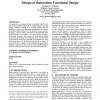Free Online Productivity Tools
i2Speak
i2Symbol
i2OCR
iTex2Img
iWeb2Print
iWeb2Shot
i2Type
iPdf2Split
iPdf2Merge
i2Bopomofo
i2Arabic
i2Style
i2Image
i2PDF
iLatex2Rtf
Sci2ools
DESRIST
2009
Springer
2009
Springer
A theory-based alternative for the design of instruction: functional design
An approach to instructional design is described which avoids some of the problems traditionally associated with process design models, sometimes referred to as waterfall models. The new approach is based on the functional decomposition of a generic instructional artifact and the use of the functions as entry points to the design. A theory of design architecture is described that relates artifact functions to the “layers” of a design, similar to Schön’s architectural domains. By viewing the instructional artifact functionally, the designer takes advantage of the correspondence of instructional design layers and their associated theories. Thus, instructional theory can be applied more directly to designs. A design order that is adaptive to the individual design project is obtained as the process order restraints of the waterfall model are traded for ordering on the basis of a set of decision priority rules. Categories and Subject Descriptors D.2.2 [Design tools and techniques] G...
Related Content
| Added | 24 Jul 2010 |
| Updated | 24 Jul 2010 |
| Type | Conference |
| Year | 2009 |
| Where | DESRIST |
| Authors | Andrew S. Gibbons |
Comments (0)

